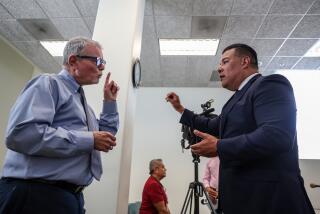DONALD D. STEFFENSEN : Developers’ Point Man : Builder Group Chief Leads Fight Against Slow-Growth
- Share via
Not long ago, few people outside Southern California’s building industry would have recognized Donald D. Steffensen’s name. As the executive in charge of home building at Irvine’s Lusk Co., his is an important job but not a high-profile one. But he is getting better known, and the circumstances aren’t entirely congenial.
Steffensen is the spokesman for Southern California’s powerful building industry in its fight against slow-growth initiatives that will go before voters this year in Orange, San Diego and Riverside counties.
After Steffensen, 53, became president of the Building Industry Assn. of Southern California last fall, the trade group sued the Board of Supervisors in a bid to knock the Orange County initiative off the June 7 primary ballot.
The Lusk Co. has a record of being litigious when its interests are threatened. The company sued San Clemente after residents in 1986 voted to limit the number of houses that could be built in some of the city’s fastest-growing neighborhoods. And it sued again this year when San Clemente officials placed a city slow-growth initiative on the June 7 ballot.
All three suits were lost. The builders and their allies are waiting to see how the election goes before mobilizing their squadron of lawyers for another assault on the county measure, which would prohibit new construction near congested roads in unincorporated areas of the county unless roads are first greatly improved. The Lusk Co., however, went ahead and asked an appeals court to reconsider its lawsuit.
In an interview with Times staff writer Michael Flagg, Steffensen talked recently about the initiative and the impact the industry believes that the measure will have on the county.
Q.: Recent surveys indicate that many county business executives plan to vote for the slow-growth initiative, even though they expect it to cause at least some harm to the county’s economy. Does that surprise you?
A.: Yes. I think it’s because people don’t really understand what slow-growth initiatives are all about. One of the things our industry has to do--the whole business community has to do--is tell people this isn’t a problem-solving initiative, it simply stops everything. I think it’ll just make the problem much worse. The other thing that people perhaps don’t think about is the long term. A lot of the reason we have such a great county is because there’s been free-enterprise growth in the market. Improvements to the infrastructure and what a lot of people refer to as “quality of life” have occurred because we’ve let the marketplace work. I’m a great believer in supply and demand, and when you tinker with it, you generally end up with some problems. So I think there’s shortsightedness, maybe, on some people’s part who think you can stop growth and the economy will continue as it did before. I don’t think that’s true.
Q.: Does the vote suggest to you a power shift in the business community, that there are now a lot more diverse and competing interests out there?
A.: I don’t think so. I think it’s just frustration with our transportation system. That’s the fundamental issue. It’s certainly the one you hear people talking about, the one they’re most frustrated with, and that’s the time it takes to get from Point A to Point B.
Q.: Supporters of the initiative say county government had reports as early as 10 years ago warning that new construction was outstripping the capacity of the county’s roads. How much of the blame for the traffic problem can be laid at the feet of the county supervisors?
A.: I think the public agencies have to carry some share of the responsibility for the problem. But you also have to remember that since Proposition 13 was approved by the voters of the state, it changed the supply and availability of public funds that had historically been used to build infrastructure.
Q.: Especially since money for improvements was short, have the supervisors and the county’s cities approved more construction than the roads and public services can handle?
A.: No, I don’t think they have. I think a lot of the large landowners in Orange County have benefited this county to the extent they haven’t put a lot of land on the market at one time. We’ve had controlled growth for a long time, but it was done in the appropriate way--at the discretion of the people who owned the land.
Q.: Your company and the Building Industry Assn. have taken what seems like a particularly aggressive stance, considering the suit against San Clemente and the suit against the county supervisors. Are you going to get more litigious? Are these suits a harbinger of an increasingly militant industry?
A.: Perhaps to some degree. But I think at some point you have to stand up for what you believe, and certainly we are strong believers that there are still some rights that go with private property.
I feel just as strongly about that for the person who owns a single-family home as I do for the person who owns thousands of acres because I think the philosophy is the same. I don’t know anybody in our industry who likes to be in litigation because it’s hardly a profit center. But I think we have to protect our businesses and protect our rights. The biggest objection I have to some of the programs being proposed is not the requirement to pay a fair share of the costs that my development adds to the infrastructure. What I object to is the requirement that you not only have to pay for the share of the infrastructure your project creates but also pay for the shortfall that may exist today as a result of prior development.
Q.: Isn’t that a bit of an overstatement? The initiative says you have to improve the roads enough to offset the traffic your project creates and make a slight improvement. You don’t have to bring it all the way up to the standards for even an acceptable traffic flow.
A.: First of all, I guess we won’t any of us know until we see whether the initiative passes and then how it’s interpreted. A “slight improvement” could mean a lot of things. And I’m not sure even a slight improvement is a reasonable obligation.
Q.: So what do you propose as a solution to the traffic problem?
A.: It’s got to be an industry approach. No one builder or landowner can solve it. I think the approaches that are being used for the Foothill and San Joaquin corridors--where industry and the public sector sat down and worked out a program and where the industry will have major participation financially--is a good example.
And that’s a change for the industry that’s occurred only in the last five to 10 years.
Q.: What about the argument that the county is giving away the candy store in these development agreements? That it’s giving up its control over big construction projects in return for roads and other improvements it would get anyway, except it might have to wait longer?
A.: It’s a trade-off. Today, with a master-planned community--and that’s what most of these projects are--you’re making a major commitment on the front end, in most cases a substantial financial commitment. You have to look at the business plan and say: “How am I going to make this work?”
So I suppose the trade-off and the value of a development agreement is an assurance that I know the parameters I’m going to have to live with in order to develop.
Q.: You’ve said the developers now are planning their projects more extensively and doing more future planning. Shouldn’t they share some of the blame for poor planning in the past?
A.: I think we share some responsibility, in terms of perhaps not looking at development on a broad enough basis and on a long-range basis. We aren’t without any responsibility.
Q.: In retrospect, now that the BIA has lost the lawsuit against the initiative in two courts, was filing it politically wise? If you had it to do over, would you file suit again?
A.: Sure. I think we would.
As I understand the requirement that the courts had to deal with on our request, it was a pretty narrow window as to whether you can take something off the ballot, versus probably a much broader look at a post-election challenge to the actual content of the initiative.
But I thought some pretty interesting comments came out of the courts on the content of the initiative and the potential for post-election challenge.
Q.: Has the suit had a negative impact politically?
A.: I think there are probably those people who felt we shouldn’t have done that, or wondered why we would do that.
But we did it, and I feel it was the right decision. We felt our constitutional rights were being challenged, and I would hope that people--if they sat back and looked and put themselves in a similar situation--wouldn’t be critical of other people following the system. I’m not sure it’s hurt us politically.
Q.: Was there a difference of opinion among the builders over filing the suit, as some rumors have it?
A.: No. In my discussions with people in the building industry and in the association and certainly with some of the major people here in Orange County, I didn’t have anyone who ever questioned going ahead and filing the suit.
Q.: Will the initiative pass?
A.: I wouldn’t speculate on it today. Certainly the polls we’ve seen would indicate it will pass. But we’ll know the day after the election.
Q.: Is the Building Industry Assn. going to take a whack at the initiative in the political arena now that the lawsuit is on hold?
A.: A number of our builders are going to support Citizens for Traffic Solutions (a political action committee that purports to have a broader political base than the builders’ trade group). In terms of an organized BIA campaign, we’re not going to have a separate campaign.
Q.: The association runs what you call an outreach program aimed at people in the building industry. How would you respond to critics of that program, who say the $250,000 it costs could have been better used for the lawsuit or the political campaign, rather than in effect preaching to the choir?
A.: I think there’s perhaps a misunderstanding of how that program got started. It had been under discussion for two or three years. It was not a program that surfaced as a result of the initiative or a program that was rushed because of the initiative.
The feeling was and continues to be that one of the things we need to do is better involve all the people in our industry in learning about the value and the place the industry has in the economy of Orange County.
Q.: How big a public relations blow to the political campaign is the revelation last week that Citizens for Traffic Solutions sent a letter to developers suggesting a way for them to hide their contributions?
A.: I don’t know enough about that to say. I’ve never seen the letter, and all I know about it is what I’ve read in the paper. I could only respond for this company: That we have always put our name where our money is.
Q.: Has Lusk Co. contributed to Citizens for Traffic Solutions?
A.: I have recommended we contribute to the group. I know this company will do it on the basis that we don’t have any problem having people know what we’re involved in and that our major contributions are reported.
Q.: Has the company conducted studies on the impact of the initiative?
A.: You aren’t going to see--if the initiative passes--a vast exodus or layoff of construction people the day after. But there’s no doubt in my mind that if it reduces the amount of construction, it’s going to have a significant effect on the economy of Orange County because it’s going to reduce the number of jobs. And those people who build the houses also buy groceries and buy cars. I think it’ll have a ripple effect as it spreads out from them.
Q.: Is it really a foregone conclusion that the initiative is going to shut down all construction in the unincorporated areas? Can’t it be construed as doing just what its supporters say: You can’t build until you fix the roads?
A.: One of the problems I have with all these programs, it’s not so much what they say as what they don’t say, and the dilemma that the public agencies face when they sit down to write the rules. We’ve gone through that with San Clemente and their measure in 1986, and that initiative was certainly a lot more specific than the one on the ballot now. And yet it took the city of San Clemente months to go through and try to interpret what that initiative said and then to establish the rules to be able to work with it. I see a lot of confusion, but how the countywide initiative is interpreted will have a great deal to do with whether it’s a total shutdown.
Q.: Realistically, what are the odds of a public agency interpreting the initiative in such a Draconian fashion?
A.: I don’t think we know, and I think the problem is that a great deal is going to depend on the involvement of the supporters. But there’s no doubt in my mind that a literal translation of what it says could absolutely stop anything that is not exempted.
Q.: And yet this seems to be the wave of the future. Slow-growth advocates from all over Southern California are talking about joining and coordinating strategy. Are you facing a whole new environment here, and should you simply get used to new rules?
A.: There’s no question we’ll see a continued increase in these slow-growth initiatives.
But you have to remember that not everyplace has the same economic climate as Southern California. There are other parts of the state that would probably welcome some of the development we’ve had. Now whether people choose to go there or not, we’ll only know after we see the results down here and have a little time to deal with the effects. I think people have to understand that you can’t just stop. You can’t control economic expansion in an area without negative effects. Things don’t remain static.
More to Read
Inside the business of entertainment
The Wide Shot brings you news, analysis and insights on everything from streaming wars to production — and what it all means for the future.
You may occasionally receive promotional content from the Los Angeles Times.










